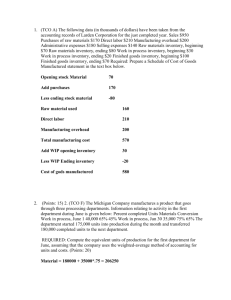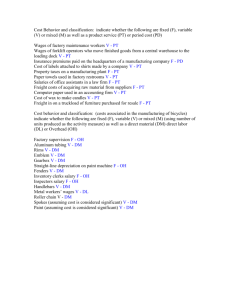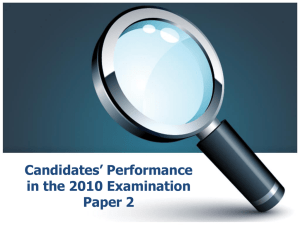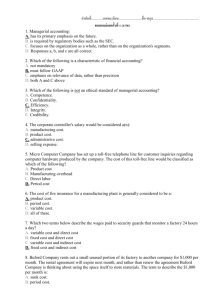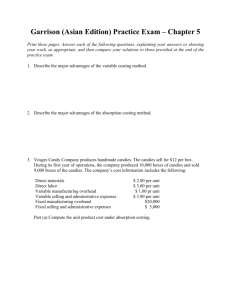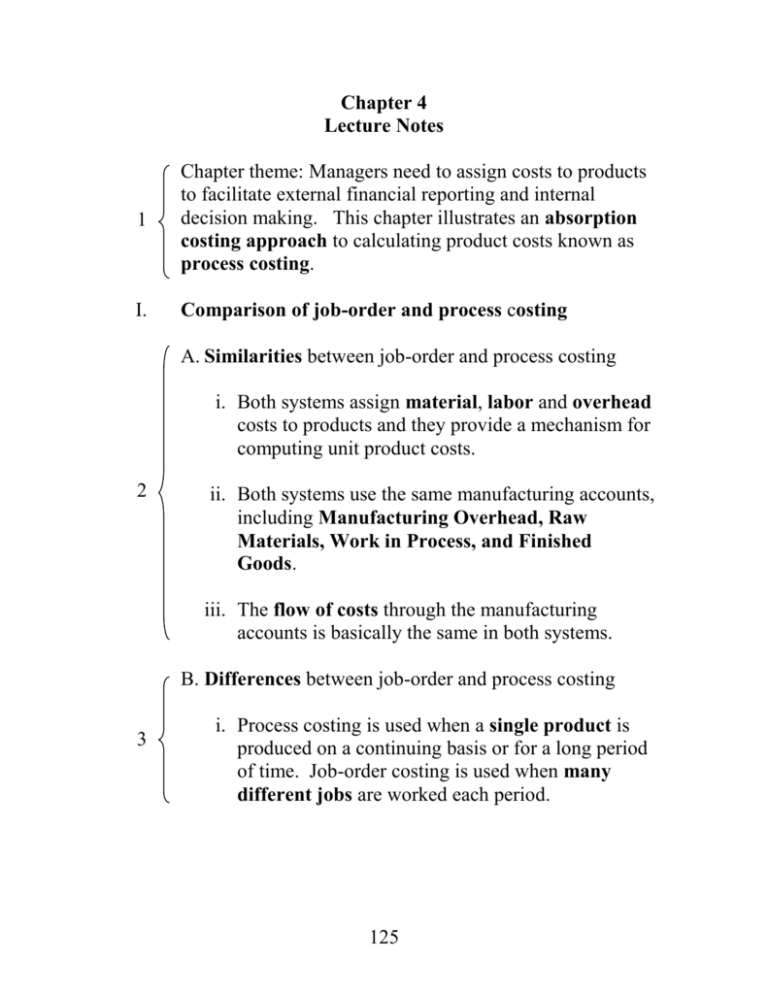
Chapter 4
Lecture Notes
1
Chapter theme: Managers need to assign costs to products
to facilitate external financial reporting and internal
decision making. This chapter illustrates an absorption
costing approach to calculating product costs known as
process costing.
I.
Comparison of job-order and process costing
A. Similarities between job-order and process costing
i. Both systems assign material, labor and overhead
costs to products and they provide a mechanism for
computing unit product costs.
2
ii. Both systems use the same manufacturing accounts,
including Manufacturing Overhead, Raw
Materials, Work in Process, and Finished
Goods.
iii. The flow of costs through the manufacturing
accounts is basically the same in both systems.
B. Differences between job-order and process costing
3
i. Process costing is used when a single product is
produced on a continuing basis or for a long period
of time. Job-order costing is used when many
different jobs are worked each period.
125
ii. Process costing systems accumulate costs by
department. Job-order costing systems
accumulate costs by individual jobs.
3
iii. Process costing systems use department
production reports to accumulate costs. Job-order
costing systems use job cost sheets to accumulate
costs.
iv. Process costing systems compute unit costs by
department. Job-order costing systems compute
unit costs by job.
4-5
Quick Check – process vs. job-order costing
“In Business Insights”
“A Hybrid Approach” (see page 167)
II.
Cost flows in process costing
A. Processing departments Any location in an
organization where materials, labor or overhead are
added to the product.
6
i. The activities performed in a processing
department are performed uniformly on all units of
production.
ii. The output of a processing department must be
homogeneous.
iii. Typically, units of product flow in a sequence from
one processing department to another.
126
B. The flow of materials, labor, and overhead costs
i. The flow of costs through the manufacturing
accounts is basically the same for process and joborder costing.
7
1. Direct material, direct labor and
manufacturing overhead are added to Work
in Process. When work in process is
completed the costs are transferred to
Finished Goods. When finished goods are
sold, the costs are transferred to Cost of
Goods Sold.
ii. Nonetheless, there is a key fundamental
difference between process and job-order costing
systems.
8
9
10
1. Job-order costing systems trace and apply
manufacturing costs to jobs.
a. One Work in Process account is often
used to accumulate costs for all jobs.
The individual job cost sheets serve
as a subsidiary ledger.
2. Process costing systems trace and apply
manufacturing costs to departments.
a. A separate Work in Process account
is maintained for each processing
department.
Learning Objective 1: Record the flow of materials,
labor, and overhead through a process costing system.
127
11
iii. T-account and journal entry views of process
cost flows (For purposes of this example, assume
there are two processing departments A and B).
Helpful Hint: Explain that the journal entries for joborder and process costing are similar, with the
exception of the specific Work in Process account for
each department under process costing.
12
13
14
1. The flow of raw material costs.
a. In T-account form:
i. Direct material costs are debited
to the appropriate departmental
Work in Process account
depending on where the materials
were added to the production
process. The Raw Materials
account is credited for the
corresponding amounts.
b. In journal entry form:
i. Debit the respective departmental
Work in Process accounts. Credit
Raw Materials.
2. The flow of labor costs.
a. In T-account form:
i. Direct labor costs are debited to
the appropriate departmental
Work in Process account
depending on where the labor
was added to the production
process. Salaries and Wages
Payable is credited for the
corresponding amounts.
128
15
16
17
18
b. In journal entry form:
i. Debit the respective departmental
Work in Process accounts.
Credit Salaries and Wages
Payable.
3. The flow of manufacturing overhead
costs.
a. In T-account form:
i. Manufacturing overhead costs
are debited to the respective
departmental Work in Process
accounts. Manufacturing
Overhead is credited by the
corresponding amounts.
1. Predetermined overhead
rates are usually used to
apply overhead to the
departments.
b. In journal entry form:
i. Debit the appropriate
departmental Work in Process
accounts. Credit Manufacturing
Overhead.
4. The flow of manufacturing costs for
partially completed units transferred from
Department A to Department B:
a. In T-account form:
i. The cost of direct materials,
direct labor and manufacturing
overhead assigned to partially
completed units from
Department A is debited to
Department B and credited to
Department A.
129
18
19
20
21
22
23
III.
24
ii. The transferred-in costs from
Department A are added to the
manufacturing costs incurred in
Department B.
b. In journal entry form:
i. Debit Work in Process
Department B and credit Work in
Process Department A.
5. The flow of manufacturing costs from the
final processing department to finished
goods.
a. In T-account form:
i. Debit Finished Goods and credit
Work in Process Department B
for the amount of the cost of
goods manufactured.
b. In journal entry form:
i. Debit Finished Goods and credit
Work in Process Department
B.
6. The flow of manufacturing costs from
Finished Goods to Cost of Goods Sold.
a. In T-account form:
i. Debit Cost of Goods Sold and
credit Finished Goods.
b. In journal entry form:
i. Debit Cost of Goods Sold and
credit Finished Goods.
Equivalent units of production
A. Equivalent units are defined as the product of the
number of partially completed units and the percentage
completion of those units.
130
24
i. Equivalent units need to be calculated because a
department usually has some partially completed
units in its beginning and ending inventory. These
partially completed units complicate the
determination of a department’s output for a given
period and the unit cost that should be assigned to
that output.
Helpful Hint: Explain that equivalent units simply
restate the ending work in process inventory as if it
were comprised of a smaller number of fully completed
units.
ii. Equivalent units the basic idea.
25
26-27
28
1. Two half completed products are equivalent
to one complete product.
2. 10,000 units 70% complete are equivalent to
7,000 equivalent units.
Quick Check – calculating equivalent units
Learning Objective 2: Compute the equivalent units of
production using the weighted-average method.
iii. Equivalent units can be calculated two ways.
29
1. The FIFO method is covered in a
supplemental appendix that can be
downloaded from the Internet.
2. The weighted-average method is included
in the text and it is covered next.
131
B. The weighted-average method of calculating
equivalent units and the cost per equivalent unit
i. Characteristics of the weighted-average method:
30
1. This method makes no distinction between
work done in the prior and current periods.
2. This method blends together units and costs
from the prior and current periods.
ii. Treatment of direct labor
31
32
1. Direct labor costs are often small in
comparison to the other product costs in
process cost systems.
2. Therefore, direct labor and manufacturing
overhead are often combined into one
classification of product cost called
conversion costs. The forthcoming
example combines these costs.
“In Business Insights”
“Cutting Conversion Costs” (see page 172)
iii. An example of the weighted-average method
33
34
1. Assume that Smith Company reported
activity for June as shown on this slide.
2. The first step in calculating the equivalent
units is to identify the units completed and
transferred out of Department A in June
(5,400 units).
132
35
36
3. The second step is to identify the equivalent
units of production in ending work in
process with respect to materials for the
month (540 units) and adding this to the
5,400 units from step one.
4. The third step is to identify the equivalent
units of production in ending work in
process with respect to conversion for the
month (270 units) and adding this to the
5,400 units from step one.
Helpful Hint: Explain that there will most likely be
differences in the equivalent unit calculations between
material and conversion costs, as materials are usually
added at the beginning of production, while conversion
costs are added during the period.
37
38
39
5. The equivalent units of production equals
the units completed and transferred out
(5,400 units) plus the equivalent units
remaining in work in process (540 units for
materials and 270 units for conversion).
6. A different visual depiction of the equivalent
units calculation for materials is shown on
this slide.
7. A different visual depiction of the equivalent
units calculation for conversion is shown on
this slide.
Helpful Hint: The treatment of beginning inventory
under the weighted-average method often puzzles
students, since work done in the prior periods is
included in the equivalent units. Explain that this is
called the weighted-average method precisely because
it averages together beginning inventory and work
133
performed in the current period. Costs and units are
treated consistently. Both the equivalent units and the
costs that go into the unit cost calculations under the
weighted-average method include amounts already in
beginning inventory.
IV. Production report weighted-average method
“In Business Insights”
“Home Runs Galore” (see page 173)
A. There are three sections in a production report:
i. The quantity schedule shows the flow of units
through the department and a computation of
equivalent units.
40
ii. The costs per equivalent unit section shows the
computation of costs per equivalent unit.
41
iii. The cost reconciliation section shows the
reconciliation of all cost flows into and out of the
department during the period.
Helpful Hint: Explain that a production report
indicates where units and costs came from (beginning
work in process and additional units and costs) and
where these units and costs end up (finished goods and
ending work in process).
B. An example of a production report
42
i. Assume that Double Diamond Skis uses the
weighted-average method of process costing to
134
42
determine unit costs in its Shaping and Milling
Department.
43
ii. Assume the following facts as shown on this slide.
44
Learning Objective 3: Prepare a quantity schedule
using the weighted-average method.
iii. The first step is to prepare the quantity schedule
and compute the equivalent units.
45
46
47
48
1. Calculate the units to be accounted for
(5,200 units) and the allocation of those
units between “completed and transferred”
(4,800 units) and ending work in process
(400 units).
2. Calculate the equivalent units in ending
work in process with respect to materials
(160 units) and add these units to the units
completed and transferred (4,800 units) to
obtain total equivalent units with respect to
materials for the period (4,960 units).
3. Calculate the equivalent units in ending
work in process with respect to conversion
(100 units) and add these units to the units
completed and transferred (4,800 units) to
obtain the total equivalent units with respect
to conversion for the period (4,900 units).
Learning Objective 4: Compute the costs per equivalent
unit using the weighted-average method.
135
iv. The second step is to calculate the cost per
equivalent unit.
49
50
51
52
53
1. Generally speaking, the cost per equivalent
unit is calculated by dividing the costs for
the period by the equivalent units of
production for the period.
2. Calculate the total material and conversion
costs to be accounted for during the period
by summing the costs added during the
period ($368,600 for materials and
$350,900 for conversion) and the costs in
beginning work in process ($9,600 for
materials and $5,575 for conversion).
3. Calculate the cost per equivalent unit for
materials ($76.25).
4. Calculate the cost per equivalent unit for
conversion ($72.75), and the total cost per
equivalent unit ($149.00).
Learning Objective 5: Prepare a cost reconciliation
using the weighted-average method.
136
v. The third step is to prepare a cost reconciliation.
54
55
56
1. Enter the number of units completed and
transferred out during the period (4,800
units) as well as the equivalent units of
materials and conversion in the ending work
in process (160 units for materials and 100
units for conversion).
2. Multiply the number of units completed and
transferred out (4,800 units) by the total cost
per equivalent unit ($149) to obtain the cost
of units transferred out during the period
($715,200).
3. Multiply the number of equivalent units in
ending work in process with respect to
materials (160 units) by the material cost
per equivalent unit ($76.25) to obtain the
total material cost in ending work in process
($12,200).
4. Multiply the number of equivalent units in
ending work in process with respect to
conversion (100 units) by the conversion
cost per equivalent unit ($72.75) to obtain
the total conversion cost in ending work in
process ($7,275).
5. Sum all costs included in the reconciliation
to obtain total cost accounted for
($734,675).
137
V.
Appendix 4A: FIFO method (slide 57: title slide)
A. FIFO vs. weighted-average method
i. The FIFO method (generally considered more
accurate than the weighted-average method) differs
from the weighted-average method in two ways:
58
59
1. The computation of equivalent units
2. The way in which the costs of beginning
inventory are treated in the cost
reconciliation report.
Learning Objective 1: Compute the equivalent units of
production using the FIFO method.
B. Equivalent units FIFO method
i. Let’s revisit the Smith Company example that was
used to illustrate the weighted-average method.
60
61
62
63
1. Assume the following activity, as shown on
the slide, is reported in Department A for the
month of June.
2. The first step is to determine the number of
units completed and transferred out of
Department A in June (5,400 units).
3. The second step is to add the equivalent
units of production in ending work in
process inventory (540 units for materials
and 270 units for conversion) to the units
completed and transferred out.
4. The third step is to subtract the equivalent
units in beginning work in process inventory
(120 units for materials and 60 units for
138
63
64
65
conversion) from the sum of the units
completed and transferred out and the
equivalent units in ending work in process
inventory.
a. This calculation results in 5,820 and
5,610 equivalent units of materials
and conversion, respectively.
5. A different visual depiction of the
calculation of equivalent units with respect
to materials is as follows.
6. A different visual depiction of the
calculation of equivalent units with respect
to conversion is as follows.
C. Comparing equivalent units of production under the
weighted-average and FIFO methods
i. The equivalent units in beginning inventory are
subtracted from the equivalent units of production
per the weighted-average method to obtain the
equivalent units of production under the FIFO
method. This can be illustrated using the Smith
Company example as follows:
66
1. The equivalent units of material produced
per the weighted-average method (5,940
units) minus the equivalent units of material
in beginning inventory (120 units) equals
the equivalent units of production per the
FIFO method (5,820 units).
2. The equivalent units of conversion per the
weighted-average method (5,670 units)
minus the equivalent units of conversion in
beginning inventory (60 units) equals the
139
66
equivalent units of production per the FIFO
method (5,610 units).
Helpful Hint: The only difference in the equivalent unit
calculations between the weighted-average and FIFO
methods is that the equivalent units in beginning inventory
are included in the weighted-average method. Emphasize
again that under the weighted-average method the costs
already in beginning inventory will be added to the costs
incurred during the period to arrive at unit costs. To be
consistent, equivalent units already in beginning inventory
must be added to the equivalent units for work performed
during the period.
D. The production report FIFO method
67
68
69
i. Let’s revisit the Double Diamond Skis example that
was used to illustrate the weighted-average method.
Assume the following activity, as shown on the
slide, is reported in the Shaping and Milling
Department for the month of May.
Learning Objective 2: Prepare a quantity schedule
using the FIFO method.
1. The first step is to prepare a quantity
schedule and to compute the equivalent
units.
a. First, calculate the total units to be
accounted for (5,200 units). This is
the sum of the units in beginning
work in process (200 units) and the
units started into production during
the period (5,000 units).
140
70
71
72
73
74
75
76
b. Second, calculate the equivalent units
of material and conversion that were
transferred from beginning work in
process to the next department (90
units for materials and 140 units
for conversion).
c. Third, calculate the number of units
started and completed during the
month (4,600 units).
d. Fourth, calculate the equivalent units
of material and conversion that are in
ending work in process inventory
(160 units for materials and 100
units for conversion).
e. Fifth, calculate the total equivalent
units for materials (4,850 units) and
conversion (4,840 units).
Learning Objective 3: Compute the costs per equivalent
unit using the FIFO method.
2. The second step is to compute the cost per
equivalent unit.
a. First, calculate the costs to be
accounted for during the period
($734,675). Notice, the costs of
beginning work in process ($15,175)
are not broken down by material and
conversion components.
b. Second, divide the costs added to the
department for materials ($368,600)
by the equivalent units of production
(4,850 units) to obtain the cost per
equivalent unit for materials
($76.00).
141
77
78
79
80
81
c. Third, divide the conversion costs
added to the department ($350,900)
by the equivalent units of production
(4,840 units) to obtain the
conversion cost per equivalent unit
($72.50).
d. Fourth, add the material and
conversion costs per equivalent unit
to obtain the total cost per equivalent
unit ($148.50).
Learning Objective 4: Prepare a cost reconciliation
using the FIFO method.
3. The third step is to prepare a cost
reconciliation.
a. First, calculate the total cost from
beginning inventory transferred to the
next department ($32,165).
i. This includes the costs in
beginning inventory ($15,175)
plus the costs incurred to
complete the unfinished
equivalent units in beginning
inventory ($6,840 for materials
and $10,150 for conversion).
b. Second, calculate the cost of units
started and completed during the
period ($683,100).
c. Third, calculate the costs in ending
work in process inventory ($12,160
for materials and $7,250 for
conversion).
d. The sum of these three numbers
($734,675) should agree with the
142
81
total costs to be accounted for in the
“Costs per Equivalent Unit” portion
of the production report ($734,675).
Helpful Hint: Remind students that the only difference
between the FIFO and weighted-average approaches is
the treatment of units in beginning inventory and the
costs of beginning inventory. In essence, the weightedaverage approach simply combines the units in
beginning inventory and the costs of beginning
inventory with all other units and all costs incurred
during the period. The FIFO method segregates the
beginning inventory. Providing that the number of
units transferred out is at least as large as the number
of units in beginning inventory, the costs already in
beginning inventory are simply transferred out under
the FIFO method.
143
144
TM 4-1
AGENDA: PROCESS COSTING
1.
Differences between job-order and process costing.
2.
Overview of cost flows in process costing.
3.
The concept of equivalent (whole) units for partially completed units.
4.
Overview of the weighted-average method for determining costs.
5.
Departmental production report using the weighted-average method.
a. Quantity schedule and computation of equivalent units.
b. Computation of costs per equivalent unit.
c. Cost reconciliation: assigning costs to units transferred out and to
ending work in process inventory.
© The McGraw-Hill Companies, Inc., 2007. All rights reserved.
TM 4-2
DIFFERENCES BETWEEN JOB-ORDER AND PROCESS COSTING
(Exhibit 4-1)
© The McGraw-Hill Companies, Inc., 2007. All rights reserved.
TM 4-3
SEQUENTIAL PROCESSING DEPARTMENTS
(Exhibit 4-2)
© The McGraw-Hill Companies, Inc., 2007. All rights reserved.
TM 4-4
T-ACCOUNT MODEL OF PROCESS COSTING FLOWS
(Exhibit 4-3)
© The McGraw-Hill Companies, Inc., 2007. All rights reserved.
TM 4-5
OVERVIEW OF PROCESS COSTING
A.
In process costing, costs are accumulated in processing departments.
B.
A separate departmental production report is compiled for each
processing department. This report provides the details of how costs
are assigned to units that pass through the department.
C.
Costs to be accounted for in each processing department consist of:
1) Costs of the beginning work in process inventory in the
department.
2) Costs added during the period.
a. Costs of units transferred in from a preceding department.
b. Costs added in the department itself.
Materials + Labor + Overhead
Conversion Costs
D. Costs are accounted for by assigning them to:
1) Ending work in process inventory in the department.
2) Units transferred out to the next department (or to finished goods).
E.
In process costing, each unit is assigned the average cost of units
processed through the department.
F.
To compute the average cost per unit in a department, two things
must be known:
1) The total cost.
2) The total number of units processed.
G. Partially completed units are converted to equivalent (whole) units.
For example, 200 units in ending inventory are 25% complete with
respect to conversion costs.
Equivalent = Number of partially × Percentage
units
completed units
completion
= 200 × 50% = 50 EUs
© The McGraw-Hill Companies, Inc., 2007. All rights reserved.
TM 4-6
OVERVIEW OF PROCESS COSTING (continued)
H. The two common methods of computing average costs per unit are
the weighted-average method and the FIFO method. The FIFO method
is covered in the Chapter 4 Supplement on the Internet.
© The McGraw-Hill Companies, Inc., 2007. All rights reserved.
TM 4-7
WEIGHTED-AVERAGE METHOD
• The weighted-average method averages together the beginning work in
process inventories with the units started during the current period.
• For each category of cost in each processing department the following
calculations are made:
Costs to be
Costs of
Costs added
accounted = beginning WIP + during the
for
inventory
current period
Equivalent
Units
Equivalent units
units of = transferred + in ending WIP
production
out
inventory
Units transferred out of the department
are 100% complete with respect to
the work done in the department.
Cost per = Costs to be accounted for
EU
Equivalent units of production
Costs of units =
Units
× Cost
transferred out
transferred out
per EU
Costs of units in
= Equivalent units in × Cost
ending WIP inventory
ending WIP inventory
per EU
© The McGraw-Hill Companies, Inc., 2007. All rights reserved.
TM 4-8
EXAMPLE: Halsey Company makes small sailboats. During the most recent
month, the following activity was recorded in the hull fabrication
department for conversion costs.
Work in process, beginning (80% complete) ...
Units started into production ..........................
Units transferred out .....................................
Work in process, ending (30% complete) .......
Conversion Costs:
Work in process, beginning ............................
Conversion costs incurred during the month ...
15,000
180,000
175,000
20,000
units
units
units
units
$24,000
$338,000
Costs to be
Costs of
Costs added
accounted = beginning WIP + during the
for
inventory
current period
= $24,0000 + $338,000 = $362,000
Equivalent
Units
Equivalent units
units of = transferred + in ending WIP
production
out
inventory
=175,000 + (20,000 × 30%) = 181,000
Cost per EU =
=
Costs to be accounted for
Equivalent units of production
$362,000
= $2 per EU
181,000 EU
Costs of units =
Units
× Cost
transferred out
transferred out
per EU
= 175,000 × $2 = $350,000
Costs of units in
= Equivalent units in × Cost
ending WIP inventory
ending WIP inventory
per EU
= (20,000 × 30%) × $2 = $12,000
© The McGraw-Hill Companies, Inc., 2007. All rights reserved.
TM 4-9
PRODUCTION REPORT
The production report summarizes all of the activity and cost flows in a
department.
The production report has three separate, but highly interrelated, parts:
1. A quantity schedule with equivalent units.
2. Computation of costs per equivalent unit.
3. A reconciliation of all cost flows into and out of the department
during the period.
EXAMPLE: The following data are for the first processing department at
Midwest Refining, a company that reclaims petroleum products from used
motor oil.
Work in process, beginning:
Units in process...........................
Percentage completion ................
Cost of beginning inventory .........
Units started into production ..........
Costs added in the department
during the current period .............
Units completed and transferred .....
Work in process, ending:
Units in process...........................
Percentage completion ................
Units
10,000
190,000
180,000
20,000
Materials
Conversion
60%
$4,300
50%
$7,600
$74,100
$140,400
80%
25%
© The McGraw-Hill Companies, Inc., 2007. All rights reserved.
TM 4-10
QUANTITY SCHEDULE AND EQUIVALENT UNITS:
WEIGHTED-AVERAGE METHOD
• The quantity schedule accounts for the physical flow of units through a
department for a period.
• The equivalent units are also shown for the units transferred out of the
department and for ending work in process inventory.
Units to be accounted for:
Work in process, beginning .......
Started into production .............
Total units to be accounted for.....
Units accounted for as follows:
Units transferred out .................
Work in process, ending* ..........
Total units accounted for .............
Quantity
Schedule
10,000
190,000
200,000
180,000
20,000
200,000
Equivalent Units (EU)
Materials Conversion
180,000
16,000
196,000
180,000
5,000
185,000
* Materials: 20,000 units × 80% complete = 16,000 EUs;
Conversion: 20,000 units × 25% complete = 5,000 EUs
Note: The quantity schedule is based on the following equation:
Units in beginning work in process + Units started into production
= Units transferred out + Units in ending work in process
© The McGraw-Hill Companies, Inc., 2007. All rights reserved.
TM 4-11
Weighted-Average Method
190,000 Units Started
Beginning Work
in Process:
10,000 units
60% complete
Started and
Completed:
170,000 units
Units transferred to next department
Work in process, ending:
20,000 units × 80%
Equivalent units of production
Ending Work
in Process:
20,000 units
80% complete
180,000
16,000
196,000
© The McGraw-Hill Companies, Inc., 2007. All rights reserved.
TM 4-12
COMPUTATION OF COSTS PER EQUIVALENT UNIT:
WEIGHTED-AVERAGE METHOD
Cost to be accounted for:
Work in process, beginning
Costs added ......................
Total cost to be accounted
for (a) ............................
Equivalent units (b)..............
Cost per EU (a) ÷ (b) ..........
Total
Cost
Materials Conversion
Whole
Unit
$ 11,900
214,500
$ 4,300
74,100
$ 7,600
140,400
$226,400
$78,400
$148,000
196,000
185,000
$0.40 +
$0.80 = $1.20
COST RECONCILIATION:
WEIGHTED-AVERAGE METHOD
Cost accounted for as follows:
Transferred out:
180,000 units @ $1.20 each ......
Work in process, ending:
Materials @ $0.40 per EU .........
Conversion @ $0.80 per EU ......
Total work in process, ending ......
Total cost accounted for .................
Total
Cost
Equivalent Units (EU)
Materials Conversion
$216,000
180,000
6,400
4,000
10,400
$226,400
16,000
© The McGraw-Hill Companies, Inc., 2007. All rights reserved.
180,000
5,000

